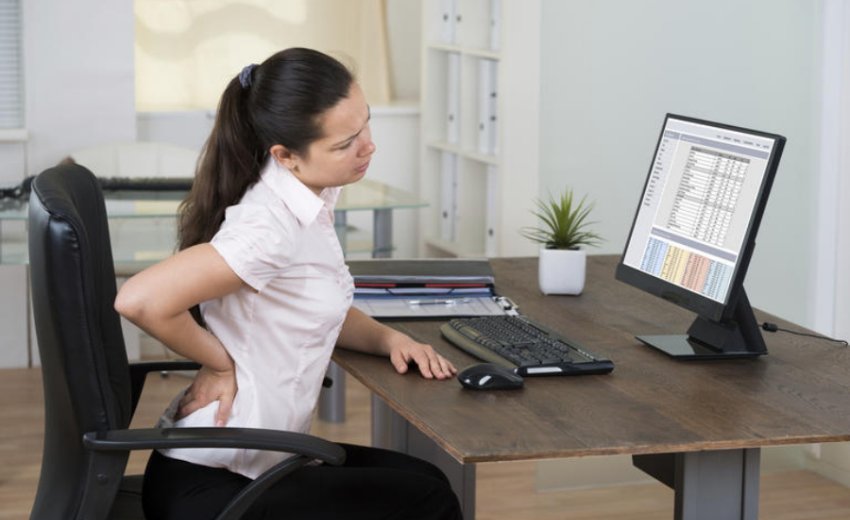How to Sit at a Desk All Day and Still be Healthy
© 2018 Health Realizations, Inc. Update
Americans spend nearly eight hours a day sitting (and another four hours watching TV and playing computer games) according to a Harris poll conducted by the America On the Move Foundation. Now consider your own day. How many hours per day do you spend sitting at a desk, either in your office or at home?
Chances are it's a pretty substantial amount of time. Between work and the endless number of things people now use computers for, you may easily be spending more time at your desk than anywhere else, which is why learning how to sit at a desk and still be healthy is so important.
The Downfalls of Sitting Too Much In general, sitting (whether at a desk, in the car or elsewhere) for too long is not a health-promoting thing to do. For one thing, it can cause you to gain weight. A study in the International Journal of Obesity and Related Metabolic Disorders found that those who had high daily levels of sitting (7.4 hours or more) were significantly more likely to be overweight or obese than those who reported low daily sitting levels (less than 4.7 hours a day).
A study in the American Journal of Preventive Medicine even found that the longer a man sits at a desk at work, the greater his chances are of being overweight.
Sitting at a desk all day also puts you at risk of back pain, particularly if you sit with poor posture, leg cramps, tense muscles and, of course, boredom.
Healthy Tips for Sitting at Your Desk
Many of us don't have a choice and must work at a desk, at least for a portion of our day. During this time, use the following tips to keep your mind and body at their best.
- Keep your body in a neutral position. This means that your joints are naturally aligned, reducing your risk of stress and strain on the muscles, tendons, and skeletal system and developing a musculoskeletal disorder (MSD), according to the Occupational Safety and Health Administration (OSHA). To achieve a neutral body position:
- Adjust your chair so your thighs are parallel with the floor.
- Choose a chair that supports your back, including the curve in your lower back (if not, place a rolled up towel or pillow behind your lower back for support).
- Your hands, wrists and forearms should be in-line and roughly parallel to the floor.
- Your head should be in-line with the torso and at a level, balanced position (or just slightly forward).
- Your elbows should be close to your body, bent at a 90- to 120-degree angle.
- Your shoulders should be relaxed and upper arms hanging naturally next to your body.
- Your feet should be flat on the floor or supported by a footrest.
- Your chair should be well-padded.
- Move around often. Your body can only tolerate being in one position for about 20 minutes before it starts to feel uncomfortable, according to the Mayo Clinic. About every 15 minutes, stand, stretch, walk around or change your position for at least 30 seconds.
- Take nutritional steps to build your energy. If you feel better and more energetic, you are less likely to want to sit for long periods of time. Instead you feel more like being active and alert. Do more than take a multivitamin/mineral by discussing options that could be best for you at your next appointment. Ways to better support your body for increased vitality by building up greater energy in your body's individual cells.
- Reduce repetitive movements. Movements that you repeat over and over (such as answering the phone or reaching for a book) can lead to strains and stress. Reduce unnecessary movements as much as possible by keeping items you use often within arm's reach and using tools, such as a phone headset, to reduce repetitive movements. You should also alternate the hand you use to operate your computer's mouse.
- Keep your computer monitor in a healthy position. This means directly in front of you, but at least 20 inches away. The top of the screen should be at or below your eye level, and it should be perpendicular to the window (to reduce glare), according to OSHA.
- Look away from your computer screen often. Focusing on a computer screen for too long can lead to dry eyes and eye fatigue. Be sure to change your focus often, looking at a point in the distance, and blink regularly to keep your eyes moist.
- Use a document holder. It should be at the same height and distance as your computer monitor (holders mounted to the monitor are ideal).
- Keep your keyboard and other office accessories clean. Keyboards, phones and other office equipment are breeding grounds for germs. Desks themselves can even harbor more bacteria than a toilet seat!
- Declutter your desk. About 40 percent of U.S. office workers say they are "infuriated" by too much clutter on their desks. Save yourself this mental strife by taking a few minutes each day to go through papers. Throw away those you don't need and file those you do.
- Don't keep junk food at your desk. The temptation is simply too high to eat the junk, and subsequently feel sluggish, tired or guilty. Instead, keep a supply of healthy snacks nearby to satisfy your hunger in a smart way. Great snack ideas include cut-up vegetables, a few nuts, fresh fruit, a hard-boiled egg, etc.
- Make your desk your own. While keeping away from too much clutter is good, adding a few items that mean something to you will make your desk more enjoyable to work at. Some items to consider include a few pictures of family or friends, a plant, inspirational posters or paintings for the wall, and any other mementos that make you feel good.
Sources
International Journal of Obesity and Related Metabolic Disorders;27(11):1340-6.
American Journal of Preventive Medicine.29(2): 91-97.U.S. Department of Labor.
Occupational Safety and Health Administration





